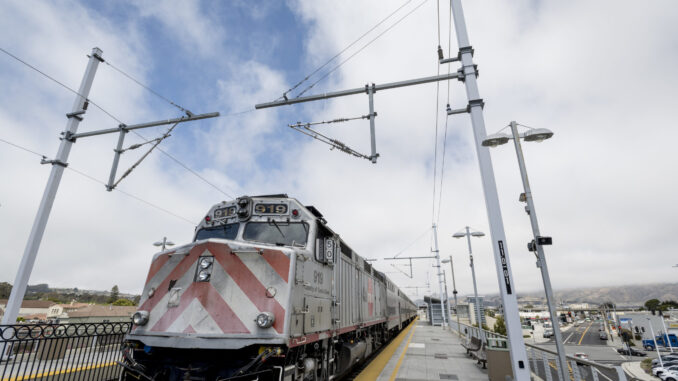
(The Center Square) – A Caltrain project that would electrify a corridor of stations in the Bay Area is coming in $462 million over initial estimates, increasing the project’s price to $2.44 billion, Caltrain announced this week.
The project, scheduled to be completed by 2024, would convert diesel-hauled trains to electric trains and install a new catenary system – an overhead wire system that provides electricity to the trains – throughout several San Francisco stations. The project began in 2017, hoping to reduce greenhouse gas emissions and move the agency closer to its goal of tripling capacity on its high-speed rail line by 2040.
“The electrification of Caltrain is of great importance not only to the region, but also the state and country. The project will help address climate change by replacing our aging diesel fleet with high-performance electric trains and creates jobs from California to Utah to Pennsylvania,” Caltrain Board Chair Dev Davis said in a statement. “While it hasn’t gone as smoothly as we had hoped, we are confident that we are on track towards electrified service in 2024 that will transform how people commute throughout the Bay Area.”
In a news release, Caltrain said the increase in the project’s price tag comes from settlement and negotiations with Balfour Beatty, the contractor constructing the project and providing a budget update. According to Caltrain, the settlement “resolves commercial issues” and costs related to extending the project to 2024, while the updated budget accounts for COVID-19 related delays, real estate work and utilities.
To address the additional $462 million needed for the project, Caltrain said it is working with funding partners and delegations at the state and federal level to make up for gaps.
Currently, Caltrain has received an additional $52.4 million from the federal government and has access to $150 million in financing credit and $60 million in capital reserve toward the funding gap – leaving about $200 million left unaccounted for. Additional funding could come from the recent bipartisan Infrastructure Investment and Jobs Act and the upcoming State Transportation budget, Caltrain said.
Since starting the project in 2017, Caltrain has installed over 95% of the 3,000 foundations needed, and the organization expects to install the new catenary system in summer 2022.
With the agreement with Balfour Beatty in place, officials say Caltrain is in a better position to reach its target completion date in 2024.
“The execution of this agreement is a testament of Balfour Beatty’s committed partnership with Caltrain and our promise in providing a realistic, cost-effective, quality and timely solution that we can all mutually deliver upon,” Leon Blondin, chief executive officer of Balfour Beatty US, said in a statement. “We will continue to work safely and sustainably to electrify and upgrade the service, capacity and reliability of the transit system on behalf of commuters in San Francisco, San Mateo and Santa Clara counties.”
This Caltrain project is also helping to advance a project from the California High Speed Rail Authority, which is aiming to connect mega-regions of the state by creating a system that runs from San Francisco to Los Angeles in under three hours. One portion of this project is located between San Francisco and San José, aiming to connect Silicon Valley communities to the rest of the state.
Caltrain and the Authority are working together to electrify the San Francisco corridor and plan share tracks in a blended system, according to the Authority.
As of 2016, the Authority committed to providing and additional $113 million to the corridor electrification project, bringing its total contribution to $714 million.
— Madison Hirneisen, The Center Square




